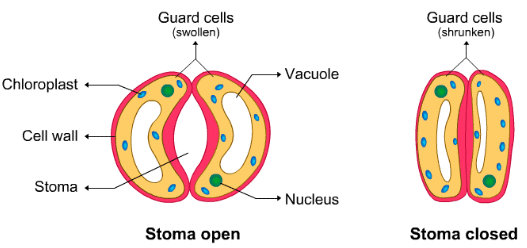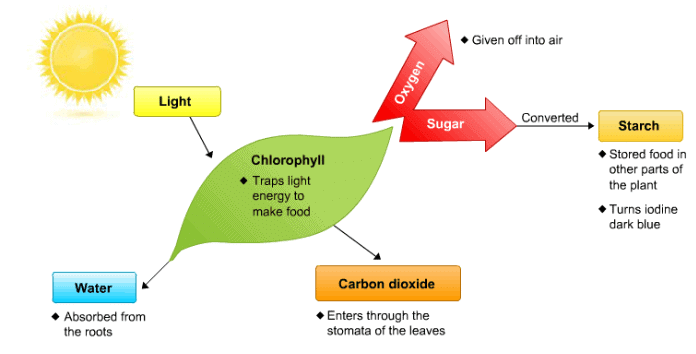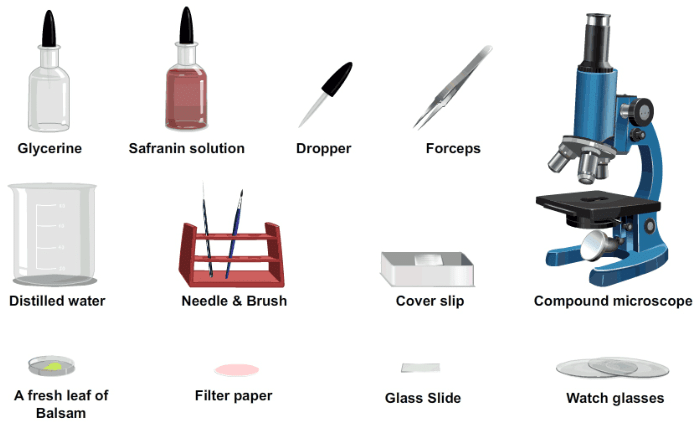Theory & Procedure, Demonstration of Stomata on a Leaf Peel | Science Class 10 PDF Download
Objective
Our objective is to prepare a temporary mount of a leaf peel to show stomata.
Theory
Stoma (plural stomata), a word derived from Greek which means ‘mouth’, is a pore found in the epidermis of leaves, stems and all other plant parts found above the ground. Stomata are thus named because they permit the exchange of gases between the atmosphere and the inside of the leaf.
Structure of Stomata
The size and shape of stomata vary in different plants. The structure of the stomata consists of a kidney shaped epidermal cell with an opening in the centre known as the pore. The stomata are bordered by a pair of specialised parenchyma cells known as the guard cells that are responsible for regulating the size of its opening, thus saving the plant from water loss. When fully stretched, the guard cells expand and thereby open the stomata. When the guard cells lose water, they shrink and the stomata will close. Guard cells also have large vacuoles. The cells that surround the guard cells are known as subsidiary or accessory cells. The guard cells in dicot plants are kidney shaped and dumbbell shaped in monocots.

Position of Stomata
Although stomata are found on the epidermis of leaves, the exact positioning is different from plant to plant. Stomata are found on either both sides or on just one side of the leaf. When the stomata are present on both sides of the leaf, they are called amphistomatic; epistomatic, if present on the upper side; and hypostomatic, if present on the lower side.
The distribution of stomata varies in different plants. There are more stomata on plant surfaces in conditions like lower atmospheric carbon dioxide concentrations, moist environments and higher light. In dicot plants the number of stomata is greater on the lower surface than on the upper surface of the leaf. On the other hand, monocot plants have the same number of stomata on both surfaces of the leaf. In the case of floating plants, stomata is found only on the upper epidermis.
Functions of Stomata
The major function of stomata is the exchange of gases by taking carbon dioxide from the atmosphere and giving out oxygen that is used by human beings and animals. They help in photosynthesis and transpiration.
Photosynthesis
Photosynthesis is a process used by plants to manufacture food with the help of sunlight, carbon dioxide and water. It is through the stomata that the plant takes carbon dioxide from the atmosphere. The water molecule is broken down into hydrogen and oxygen, and it is through the stomata that the oxygen is then released as a by-product in the atmosphere. Stomata are the medium of gaseous exchange and cellular respiration in plants.

Transpiration
Transpiration is a process of evaporation of water from the surface of the plant. This keeps the plant cool and transfers minerals and other materials to different parts of the plant. As the plant takes water from the soil, the openings absorb other minerals. For a plant to take water from the soil, water needs to evaporate from the surface of the plant. Once this happens, pressure is developed that forces the roots to absorb water from the soil and transfer it to the tips of the plant. It is through the stomata that the major work of evaporation of water is done.
Learning outcomes
- Students understand the structure and function of Stomata.
- Students understand the processes of photosynthesis and transpiration.
- Students will be able to perform the experiment more accurately in the real lab having observed the animation and simulation.
Materials Required

Real Lab Procedure
- Pluck a fresh leaf from a balsam plant.
- Fold the leaf and carefully tear along the bruised area of the lower side of the leaf.
- We can see a colourless narrow border along the torn edge.
- Carefully pull out the thin membranous transparent layer from the lower epidermis using a forceps.
- Put the epidermis into a watch glass containing distilled water.
- Take few drops of Safranin solution using a dropper and transfer this into another watch glass.
- Using a brush transfer the epidermis into the watch glass containing the Safranin solution.
- Keep the epidermis for 30 sec in the Safranin solution to stain the peel.
- To remove excess stain sticking to the peel, place it again in the watch glass containing water.
- Place the peel onto a clean glass slide using the brush.
- Take a few drops of glycerine using a dropper and pour this on the peel.
- Using a needle, place a cover slip over the epidermis gently.
- Drain out the excess glycerine using a blotting paper.
- Take the glass slide and place it on the stage of the compound microscope.
- Examine the slide through the lens of the compound microscope.
Simulator Procedure (as performed through the Online Labs)
- You can select the type of view from the ‘Select view’ drop down list (it is the 'Binocular view' through which you can view the cell structure).
- Select the permanent slide of the leaf peel from the ‘Select sample’ drop down list.
- You can change the power of the lens from the ‘Select objective lens’ drop down list.
- For coarse adjustments, you can click on the left and right arrows of 'Course Adjustment' seen on the left controls panel.
- For fine adjustments, you can click on the left and right arrows of ‘Fine adjustment’ seen on the left controls panel.
- Using the scroll bar, scroll down the screen for the ‘Slide adjustment’, which lets you observe each part by clicking on the four way directional arrow.
- You can select the ‘Identify parts’ check box to see the labelled parts of the stomata.
- To redo the experiment, click on the ‘Reset’ button.
Observations
- The epidermis is made of uniseriate layers of cells that have distinct cell walls, a nucleus and cytoplasm, and are closely packed.
- The epidermal layers are broken at places. These openings are the stomata.
- Each stoma is guarded by a pair of bean shaped cells that are guard cells.
Precautions
- The epidermal peel should be taken from a freshly-plucked leaf.
- Take the epidermal layer from the lower surface of a leaf, as it has more stomata.
- Always use a clean glass slide.
|
80 videos|513 docs|74 tests
|
FAQs on Theory & Procedure, Demonstration of Stomata on a Leaf Peel - Science Class 10
| 1. What is the purpose of conducting a stomata demonstration on a leaf peel? |  |
| 2. How can one prepare a leaf peel for stomata demonstration? |  |
| 3. What is the significance of studying stomata on a leaf peel? |  |
| 4. How can one observe and count stomata on a leaf peel? |  |
| 5. Can you explain the structure and function of stomata? |  |

























